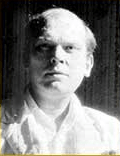Olaf Bull

His life
Olaf Bull's parents were author Jacob Breda Bull and his second wife Maria Augusta Berglöf. Bull grew up and was mostly raised in Kristiania. At the age of 13, he lived for some time in Hurum in Buskerud, where his father worked as a writer.
He started gymnasium in 1899, and the same year he published his first poem in the school newspaper. After he finished gymnasium, he lived with his family in Rome before returning to Kristiania in 1903 to begin his studies at the university. Olaf Bull could be considered a polymath because in addition to both modern and classical literature, he mastered philosophy, history, politics, art and science. He was known as the “Oslo-poet,” but he lived for extended periods in both France where his son, the poet Jan Bull, was born, and in Italy. He spent several years as a journalist for Posten and Dagbladet .
Olaf Bull is buried at Vår Frelsers gravlund in Oslo.
His poetry
Bull's poetry collection ‘‘Digte’’ (Poems) (1909) formed the foundation upon which he came to be recognized as Norway’s foremost poet. Olaf Bull composed his poetry using what is called in Norwegian sentrallyrikk — poems about “central themes” such as love, sorrow and death. He used fixed stanza patterns and was known for his strong and emotional depictions. His poetry and work conveys a melancholy sense that all is transitory. In spite of this disconsolate tone, his recurring and powerful use of mood, faultless form and expressive voice communicate his belief that, although evanescent, art and beauty are important.
Giovanni Bach described his work in this way:
- "His poems reveal a masculine power and a forceful affirmation of his own individuality, notwithstanding the extreme pessimism that often envelopes them in a voluminous thick black veil. His poetry is deeply felt, rich in imaginative and intellectual quality." [1]
Bull utilized his extensive knowledge and artistic strength, but showed an underlying fear and depression. He inherited a nervous disposition from his father and abused alcohol. Olaf Bull was known to be anti-authority and was regarded an “outsider” in society, but his poetry demonstrated that he never totally broke with traditional form and structure. Much of his poetry showed a powerful longing for the eternal and persistent. This longing was most apparent when he wrote about classical motifs.
Bull and Joyce
While James Joyce was working on Finnegans Wake, he wanted to insert references to Scandinavian languages and literature, hiring five teachers of Norwegian. Bull was the first one. Joyce wanted to read Norwegian works in the original language, including Peter Andreas Munch's Norrøne Gude- og Heltesagn (Norse tales of gods and heroes). He was looking for puns and weird associations across the barriers of language, which was something Bull well understood. Lines from Bull's poems echo through "this spider's web of words", as Joyce himself called Finnegans Wake, and Bull himself materializes under the name "Olaph the Oxman", a pun on his surname.
In his letters home, Bull mentioned nothing about Joyce, most likely because he often asked his family for money, which would sound unconvincing with him at the same time being a teacher for a world-famous author. It is not known how Joyce got in contact with Bull, but both frequented the bookstore Shakespeare and Company in Paris which was run by Sylvia Beach, who may have brought them in contact with each other. In 1926 Ulysses was issued as a pirate copy in the USA, meaning that Joyce would receive no money for it. Together with Beach he wrote a protest letter, intending it to be signed by well-known writers from the whole of Europe. Beach mentions in her memoirs that Joyce was particularly eager to have Bull sign it. Beach tracked Bull, who had left Paris to live in the French countryside. On behalf of Joyce she sent a man there to have the protest signed. Bull's wife Suzanne provided him with a copy of Bull's signature.[2]
Bibliography
Works published during his lifetime
- Digte (Poems), Gyldendal, 1909.
- Nye Digte (New Poems), Gyldendal, 1913.
- Mitt navn er Knoph (My Name is Knoph), Narveson, 1914 - the first Norwegian book to be translated to Danish; see Norwegian language struggle.
- Digte og noveller (Poems and Short Stories), Gyldendal, 1916
- Samlede digte 1909–1919 (Collected Poems), Gyldendal, 1919.
- Stjernerne (= The Stars), Gyldendal, 1924.
- Metope, Gyldendal, 1927.
- De hundrede aar (The Hundred Years), Gyldendal, 1928.
- Kjærlighet (Love), Gyldendal, 1929.
- Oinos og Eros (Oinos and Eros), Gyldendal, 1930.
- Ignis ardens, Gyldendal, 1932.
Play
- Kjærlighetens farse:tre akter (Love’s Farce: Three Acts), Aschehoug, 1919, published 1948. Written together with Helge Krog.
Posthumously published works
- Ekko og regnbue: notater fra en dikters verksted (Echo and Rainbow: Notes From a Poet’s Workplace), Gyldendal, 1987. Edited by Frans Lasson.
- Olaf Bull: brev fra en dikters liv (Olaf Bull: Letters from a Poets Life), 2 vols., Gyldendal, 1989. Edited by Frans Lasson.
- Ild og skygger: spredte notater fra et dikterliv (Fire and Shadows: Scattered Notes from a Poet's Life), Nørhaven, Viborg, 1991. Edited by Frans Lasson.
Literature about Bull
- Suzanne Bull, Ni år: mitt liv med Olaf Bull (Nine years: My Life with Olaf Bull), Aschehoug, 1974.
- Petter Næss, "Olaf Bull, a wretched giant of Scandinavian literature (unpublished article, 1990)
- Nete Smith, Olaf Bull, in: Twentieth Century Norwegian Writers, vol. 297, Gale Dictionary of Literary Biography, 2004
- Fredrik Wandrup, En uro som aldri dør. Olaf Bull og hans samtid (A Restlessness That Never Dies. Olaf Bull and His Time), Gyldendal, 1995.
References
|